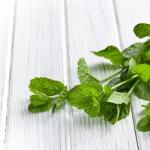Mint is a fragrant plant used in various fields. This is cooking, medicine, cosmetology. The question of how to properly store mint occupies many, since the period of natural growth of the plant is short, and you want to keep memories of summer throughout the year.
On winter evenings, it is pleasant to treat yourself to tea with a refreshing aroma of menthol, which is an expressive component of the plant with an additional tonic effect.
Having familiarized yourself with popular recipes for storing a green miracle, you can stock up on mint taste and smell for a year. You can use prepared greens:
- for cooking and decorating various dishes;
- for the purpose of refreshing and whitening the skin of the face (masks, lotions);
- as a soothing drink (mojito, cocktails with the addition of mint flavor);
- for baths and trays;
- as a medicine (infusions, decoctions).
So that mint does not lose its qualities, it should be harvested for the future, following simple recommendations.
Features of mint storage
- The plant has the most useful properties in late June - early July, that is, during the period of active flowering, so harvesting for the future must be planned for this period.
- Young stems are suitable for storage with an abundant amount of fragrant leaves, which contain a high concentration of essential oils.
- It is recommended to collect mint after the dew disappears, but no later than 11 am.
Only mint harvested in the specified time period will delight you with its minty taste and delicious smell. Of the most successful storage methods, the usual drying of the plant or its freezing is used.
Mint can be harvested whole sprigs or individual leaves.
Raw material preparation
Harvested plants need careful preparation before storing in any way you like. The algorithm for preparing raw materials is almost the same for all recipes.

To get a good result you need:
- sort out the stems with leaves, removing dry fragments, weeds, accidentally caught debris and insects;
- rinse the plants under running water, put in a colander;
- lay out on a towel and wait for the removal of excess moisture;
If only leaves are to be stored, they must be removed from the stems. It is better to do this with your hands, without using metal objects - secateurs, scissors, a knife. This will prevent the possibility of an oxidative process that provokes early spoilage of products.
How to store fresh mint
The collected mint quickly fades, as a result of which it loses not only its original freshness, but also its useful qualities.
Storage in the refrigerator is the best option, which allows you to keep the freshness of the product for a week.
Having prepared emerald greens in the manner described above, they are kept in a refrigerator using simple tricks:
- Put the stems of the plant in a jar of water. By changing the water daily, you can keep the freshness of greens up to 10 days.
- Place the bunch of mint in a plastic container with a tight lid to keep air out. The duration of use is 5-7 days.
- Spread the stems in a thin layer on a damp cloth, roll it into a roll. Shelf life - 3-4 days.
These recipes allow you to briefly prolong the good condition of mint. However, it quickly loses color saturation. In addition, other products have the ability to absorb odors emitted by the plant.

Drying mint
An old tried and tested method of storing plants is drying. Its use allows you to save all the taste, color and menthol smell. There are several drying options:
- natural - in a well-ventilated place;
- use of a microwave oven;
- drying in the oven.
Drying in the oven and microwave reduces the preparation time, however, as a result of heat treatment, the product loses a significant amount of useful properties, essential oils simply disappear during such processing.
Natural air drying allows you to get a truly amazing result, provided that all the requirements of the preparatory stage described above are met.
The rest of the steps will not take much time:
- it is necessary to collect mint in small bunches;
- tightly tie the lower part of the stems with a strong thread or twine;
- hang bunches of mint down with inflorescences so that all substances are concentrated in the leaf zone.

The room should be well ventilated without direct sunlight on the plant.
After the stems and leaves have completely dried, the resulting raw material must be placed in a dry glass container (preferably dark in color), tightly closed and placed in a dark place.
Such a blank is stored for more than a year without losing its properties. Tea, meat dishes, dessert are the main uses of dried mint.
plant freezing
It is possible to prepare mint for the winter with the help of a freezer. Frozen mint, as well as when dried, retains all its qualities for 7-8 months.
whole leaves
Well-prepared greens are placed in a plastic bag with a sealed clasp.
If it is desirable to freeze only the leaves, they are first removed from the stem by hand.
An important requirement: there should be no moisture on the leaves, and air is removed from the bag using a cocktail tube.

Whole branches
To decorate festive dishes, freezing leaves with stems is suitable. This mint is also used for the preparation of infusions and decoctions used for cosmetic and medicinal purposes.
The branches of the plant are placed in a plastic bag, from which air is removed. Then the package is tightly folded into a tight tube and sent to the freezer.
finely chopped
Convenient packaging of products is more suitable for cooking first courses.
Greens are pre-chopped with a knife or in a blender, laid out in small containers and frozen.
The disadvantage of this method is that it is difficult to separate the right amount of product.
In ice cubes
The most convenient option for freezing mint is in special molds designed for freezing ice. Candy cells are also used for this purpose.
The advantage of the method is portion packaging.

Do you like refreshing mint drinks or savory meat dishes and salads? Faced with the fact that the plant quickly withers and loses its aroma. Learn how to store mint for a refreshing smell and taste.
How to store mint in the refrigerator?
If you purchased or cut fragrant greens and did not use them, store them in the refrigerator. To prevent the mint from wilting, thoroughly rinse the twigs with leaves and shake a little to remove excess water. Wrap in damp gauze or towel and refrigerate.
Washed greens can be placed in a plastic container and closed with a lid. If you don't have a suitable container, put the fragrant twigs in a disposable bag and tie tightly to keep air out. You can also put greens in a glass of water. Mint can be stored in the refrigerator for 4-5 days.
How to store mint for a long time?
The season for collecting this fragrant greenery falls on the end of July - the beginning of August. At this time, it contains the largest amount of essential oils. If you know how to properly store fresh mint, you can enjoy its pleasant aroma throughout the year.
If you want to prepare mint for the winter, then know that this can be done in two ways:
freezing;
Before freezing greens, rinse thoroughly and let dry. Fold the prepared twigs and leaves into bags or containers and send to the freezer. To make mojitos and other cold drinks, mint can be frozen in ice cube trays. Fill the molds with water, placing a couple of clean mint leaves in each compartment. Freeze.
A bouquet of fragrant mint fills the house with fragrance and peace. City fatigue, insomnia and headaches from the hustle and bustle of everyday days go away. Drinking a glass of mint decoction relieves spasm, reduces nausea, cures the throat, restores appetite, relieves stomach pains and simply refreshes on a hot day. The leaves of the plant, added to dishes during the cooking process, make the food tastier. How to keep mint for a long time? A bouquet of fragrant mint fills the house with fragrance and peace. City fatigue, insomnia and headaches from the hustle and bustle of everyday days go away. Drinking a glass of mint decoction relieves spasm, reduces nausea, cures the throat, restores appetite, relieves stomach pains and simply refreshes on a hot day. The leaves of the plant, added to dishes during the cooking process, make the food tastier. How to keep mint for a long time?
Ingredients
How to store mint
1. Wet way. You can keep mint leaves fresh for up to a week by wrapping the plant in a damp towel and putting it in the refrigerator. It looks nice on the kitchen table and a bouquet of mint, which for decoration can be put not only in a vase, but also in a can, a small tall saucepan, a flower pot or a jug. In this case, the water must be changed daily.
2. Dry way. From time immemorial, our grandmothers have been accustomed to drying medicinal herbs. Dehydrated parts of the plant can be stored for many years. True, the beneficial qualities of herbal tea are lost over time, and therefore it is recommended to renew the supply of dry mint annually.
Dry the grass like this: flowering mint is cut with a secateurs or a knife, if necessary, the lower part of the plant is washed from dust in clean water, and the water is allowed to drain. The resulting raw material (whole or cut into pieces) is laid out in a thin layer on a clean cloth in a shady place, or hung in thin bunches in a ventilated room away from sunlight. The entire aerial part of the plant has medicinal properties, but if there is a lot of mint, the housewives prefer to collect only the leaves for storage.
3. Freezing. Modern refrigerators allow you to store vegetables, berries, herbs for many months. Why not freeze mint too? Ice cubes with a fresh mint leaf in the center look especially impressive. Mint cubes can be used both in the preparation of cocktails and in soups or salads.
Additives, without which it is almost impossible to do in the kitchen. In addition, the leaves will appeal to any gourmet. In addition, regardless of, it is one of the best medicines, the main component in decoctions that are designed to heal from diseases. In this regard, consumers often wonder how to keep fresh on. The best method to achieve such a goal is mint, the main secrets and methods of which will be discussed.
Advantages of the method
- Frozen twigs or leaves of the culture completely retain their aroma and taste.
- During the freezing process, the mint vitamin complex is preserved, which brings invaluable benefits to the human body.
- Freezing is a unique opportunity to enjoy fragrant fresh mint tea in winter, decorate fresh salads and desserts with mint leaves.
- The color of the thawed leaves of the culture is saturated and bright, which cannot be achieved with.
- This method of storing fragrant spices is absolutely simple and accessible to everyone, does not require material and time costs.
Did you know? Thanks to its unique and inimitable aroma, mint has become one of the most sought-after ingredients needed for the preparation of perfumes, both for women and for men. It is mint that underlies the smells of the world's most popular brands.
When is the best time to collect
Often people complain that they adhered to all the conditions for preparing this magic potion, but the effect was not the same: mint tea is practically devoid of an attractive aroma.  The thing is that the culture was collected at the wrong time. The optimal period for collecting mint is its flowering stage. It was at this time that the leaves, inflorescences and shoots of the plant accumulate the most essential oils, menthol and nutrients, which, among other things, are producers of a rich smell.
The thing is that the culture was collected at the wrong time. The optimal period for collecting mint is its flowering stage. It was at this time that the leaves, inflorescences and shoots of the plant accumulate the most essential oils, menthol and nutrients, which, among other things, are producers of a rich smell.
If you want to prepare the leaves of the culture, they must be collected before flowering, at the stage of inflorescence tying. If you want to harvest whole stems, cut them exactly at the time of flowering, which occurs in late July - early August.
Did you know? Mint is one of the most powerful natural sedatives. She is able to relieve stress and lull even during a nervous breakdown. That is why neuropathologists advise drinking mint tea after every hard day at work, or after any stressful situations.
Freezing preparation
The process of preparing mint for freezing is quite simple: harvested healthy leaves and stems of the culture need to be thoroughly washed under running water. A clean workpiece should be laid out on a towel, or put in a colander so that it dries well. 
Freezing methods
Freezing mint raw materials is a fairly new process that has only recently begun to be resorted to. Despite this, there are many ways to freeze a culture: whole leaves, twigs, finely chopped and in ice cubes. The last option is a godsend for those who are wondering how to freeze mint for the winter for Mojito.
whole leaves
For this method of freezing, you will need to select exceptionally healthy mint leaves, without damage and stains. Clean leaves must be packaged in plastic containers or small jars and place in the freezer. Jars are best for preserving the integrity of the leaves. It is not recommended to freeze the leaves in bags, as they will lose their attractiveness.
Freezing mint leaves for the winter as a whole is the best solution that will allow you to use the fragrant plant in winter for both tea and desserts.
Whole branches
In addition to the leaves, you can also freeze whole sprigs of mint. The collected branches of the plant are inspected, cleaned and washed. After drying, they are wrapped in cling film, foil or a regular plastic bag, trying not to squeeze the branches, and placed in the freezer.
Important! It is worth remembering that the mint leaves that you are going to freeze must be fresh, in no case should they be wilted in the freezer. Withered mint loses its aroma and nutrients.
finely chopped
This method is not often resorted to, since it is believed that in the process of grinding mint raw materials lose their amazing aroma and juice, in which beneficial trace elements are concentrated.
However, this is the best option for harvesting mint. The collected raw materials are crushed (you can cut with a knife, or you can use a blender or food processor). The resulting product must be decomposed into small molds and frozen, after which, already frozen spice, pour into a tighter bag and close tightly.
Important! It is best to freeze mint at a temperature of -18°С to -23 °С.
In ice cubes
Ice cubes with mint leaves are a great option for harvesting mint for fragrant drinks and cocktails specifically the Mojito. We recommend a fairly easy recipe for how to freeze mint in cubes.
To implement this technique, you will need ice containers or small silicone molds into which mint leaves are placed and poured with chilled boiled water, so that the edges of the leaves are in the water. After that, the containers are placed in the freezer. When the cubes are frozen, they can be poured into a large bag for easy storage. 
The question of how to save mint for the winter at home is very relevant, since it is quite in demand. The plant has useful properties, original taste and pleasant aroma. It is widely used in cooking, medicine and cosmetology.
There are several ways to preserve grass: freezing, drying and growing at home. Useful tips presented in the article will help you properly prepare and store mint for the winter.
Terms and methods of storage
The shelf life of mint depends on the chosen way storage. For convenience, all information is collected in the table:

In a refrigerator
You can keep mint fresh in the refrigerator. Rinse the grass sprigs, shake off the water. Simply wrap the stems in a damp cloth or cloth and place in a container or plastic bag. Close the container well to prevent air from entering. Store mint in the vegetable drawer or on the bottom shelf of the refrigerator.
In the freezer
Mint can be stored in the freezer. The freezing process is very simple and includes several steps:
- Sort through the greens and remove sluggish, wrinkled and spoiled leaves.
- Rinse the twigs well in cool water and then pat dry with paper towels. If excess moisture is not removed, the mint will stick together in one ball, making it difficult to separate into portions after freezing.
- Fold the prepared mint in a plastic bag and send it to the freezer.

Freeze mint intended for drinks without stems, in separate leaves. Fold the prepared products in a plastic container and loosen a little to ensure normal air circulation. This will prevent the leaves from sticking together and help keep them looking appetizing.
Close the lid of the container and send the workpiece to the freezer. This method of keeping mint fresh is used in bars and catering establishments.
Defrost exactly the amount of mint that is needed at the moment. It cannot be re-frozen, because then it will lose its taste, aroma and beneficial properties.
Another popular freezing recipe is known: cut mint leaves, put them in the cells of an ice-freezing container and pour boiled water over them. Place the container in the freezer and store the product there for as long as necessary. Add frozen mint cubes to smoothies, tea or desserts.
Drying
You can preserve the taste and aroma of mint for a long time by drying. For harvesting, collect raw materials in late July - early August. During this period, the grass has the most intense taste and aroma, which provide essential oils. The well-known menthol is obtained just from mint essential oil.
To dry, sort the mint, rinse and dry well with a paper or rag towel. Tie the prepared raw materials into bundles and hang or spread out in a dry, dark place. The main requirements for drying are constant circulation of fresh air, low humidity and the absence of direct sunlight.
After complete drying, grind the leaves and break the stems. Put the blank in a glass jar with an airtight lid or a linen bag. Keep mint in a dry place.

If dried mint has expired, don't rush to throw it away. Sew a small bag and put the raw materials there. Such a sachet calms the nervous system and normalizes sleep. Also, the workpiece can be used to prepare an aromatic relaxing bath.
Growing mint on a windowsill
To always have a fresh sprig of mint on hand, you can grow it at home on the windowsill. Tear off a beautiful branch of grass from the garden and put it in a glass of water. Quite quickly, the sprout will give roots. Transplant the plant into a pot with soil and place it on a windowsill. (Or you can transplant a mint bush from the garden, transplant it into a pot and bring it into the house. This is both easier and the plant will take root faster.) Do not forget to water the mint, otherwise it will begin to wither.

Mint has a special aroma and taste, it gives dishes and drinks a touch of piquancy and freshness. To be able to use the beneficial and flavoring properties of the plant all year round, take care of harvesting grass for the winter in advance.
Video
Watch the videos to get acquainted with the nuances of preserving mint for the winter:
Young mother, wife and hostess. She prepares delicious, and most importantly, healthy dishes for the household. Therefore, he is looking for and testing various options for preserving the beneficial properties of fruits and vegetables at home. I am ready to share my experience and results of experiments with readers.
Found an error? Select the text with the mouse and click:
Ctrl+Enter
Do you know that:
It is believed that some vegetables and fruits (cucumbers, stalk celery, all varieties of cabbage, peppers, apples) have a “negative calorie content”, that is, more calories are expended during digestion than they contain. In fact, only 10-20% of the calories received from food are consumed in the digestive process.
Freezing is one of the most convenient methods for preparing a grown crop of vegetables, fruits and berries. Some believe that freezing leads to the loss of nutritional and beneficial properties of plant foods. As a result of the research, scientists have found that there is practically no decrease in nutritional value during freezing.
In little Denmark, any piece of land is a very expensive pleasure. Therefore, local gardeners have adapted to grow fresh vegetables in buckets, large bags, foam boxes filled with a special earthen mixture. Such agrotechnical methods allow you to get a crop even at home.
Both humus and compost are rightfully the basis of organic farming. Their presence in the soil significantly increases the yield and improves the taste of vegetables and fruits. In terms of properties and appearance, they are very similar, but they should not be confused. Humus - rotted manure or bird droppings. Compost - rotted organic residues of various origins (spoiled food from the kitchen, tops, weeds, thin twigs). Humus is considered a better fertilizer, compost is more accessible.
“Frost-resistant” varieties of garden strawberries (more often simply “strawberries”) also need shelter, like ordinary varieties (especially in those regions where there are snowless winters or frosts alternating with thaws). All strawberries have superficial roots. This means that without shelter, they freeze out. Assurances of sellers that strawberries are “frost-resistant”, “winter-hardy”, “tolerate frosts down to -35 ℃”, etc. are a lie. Gardeners should remember that no one has yet been able to change the root system of strawberries.
Natural toxins are found in many plants; no exception, and those that are grown in gardens and vegetable gardens. So, in the bones of apples, apricots, peaches there is hydrocyanic (hydrocyanic) acid, and in the tops and peel of unripe nightshade (potatoes, eggplants, tomatoes) - solanine. But do not be afraid: their number is too small.
In Australia, scientists have begun cloning experiments on several cold-weather grape varieties. Climate warming, which is predicted for the next 50 years, will lead to their disappearance. Australian varieties have excellent characteristics for winemaking and are not susceptible to diseases common in Europe and America.
It is necessary to collect medicinal flowers and inflorescences at the very beginning of the flowering period, when the content of nutrients in them is as high as possible. The flowers are supposed to be torn by hand, breaking off the rough pedicels. Dry the collected flowers and herbs, scattering in a thin layer, in a cool room at natural temperature without access to direct sunlight.
Oklahoma farmer Carl Burns developed an unusual variety of colorful corn called Rainbow Corn. The grains on each cob are of different colors and shades: brown, pink, purple, blue, green, etc. This result was achieved through many years of selection of the most colored ordinary varieties and their crossing.





